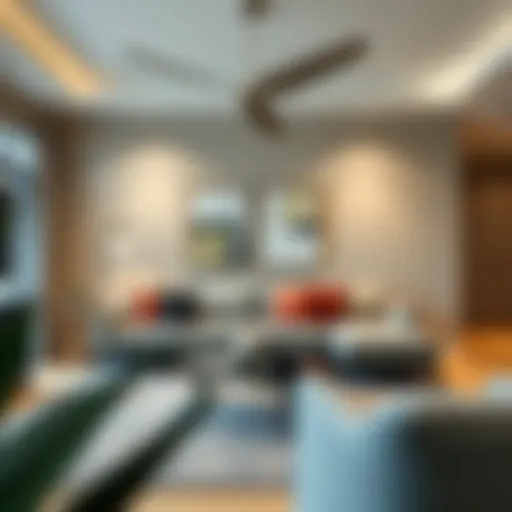Understanding Office Cabinet Pricing: Key Factors
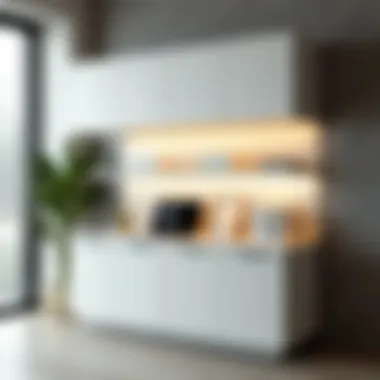
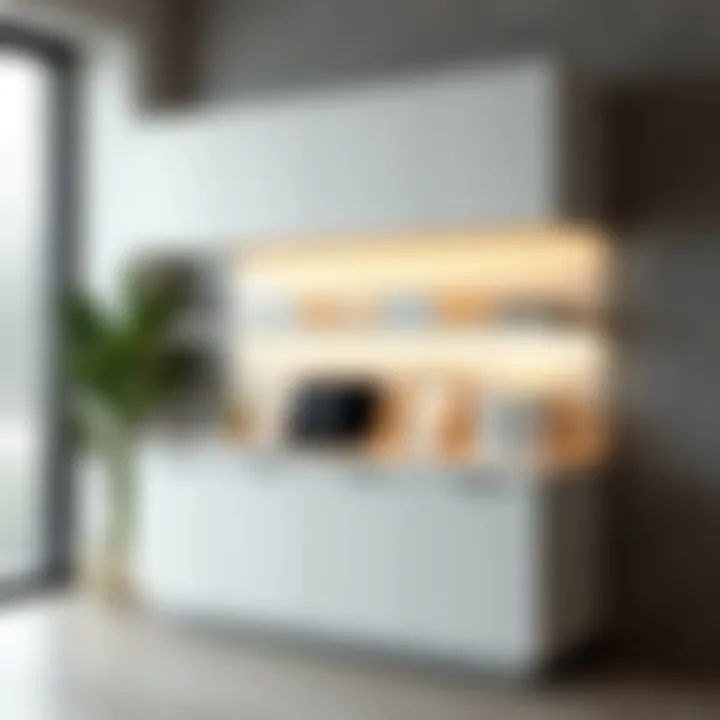
Intro
Navigating the landscape of office cabinet pricing can feel like wandering through a maze. As every office is unique, understanding what shapes the cost of a cabinet is crucial for anyone in the market to buy. This guide sets the scene by dissecting the myriad factors influencing these prices, from the types of materials used to the designs that catch the eye of consumers. Any buyer worth their salt will appreciate the need to balance cost with long-term value. Here, we have come together to bring forth an exploration that is not just insightful but necessary for making sound investments.
Furniture Trends
Current Market Trends
The world of office furniture is as dynamic as they come. Post-pandemic, the shift towards remote and hybrid work has not only reshaped how we perceive workspace designs but has also altered cabinet pricing. Today, there is a growing penchant for multi-functional pieces. An office cabinet isn’t just a storage unit anymore; it’s becoming a more integral part of workplace aesthetics and functionality.
In recent years, eco-friendly materials have gained traction. Consumers are leaning toward cabinets made from sustainable wood sources or recycled materials. Furthermore, technology integration—like built-in charging ports and smart features—has started finding its way into designs, influencing prices accordingly. It's essential to keep an eye on these emerging trends, as they heavily dictate what you should expect to pay.
Popular Styles and Designs
When it comes to styles, variety reigns supreme. You have the minimalist Scandi designs, which are often sleek and functional, appealing to the modern eye. On the flip side is the robust industrial look, marrying metal with wood for those who want a touch of urban sophistication.
Consider the following popular styles:
- Traditional: These cabins often come in rich wood finishes, embodying elegance. Think dark walnut shades that signify professionalism.
- Modern: Sleeker lines dominate this style, often found in lighter shades like white or grey.
- Modular: Perfect for the flexible workspace, these are customizable and can adapt as your needs change.
Each of these designs carries a price tag that isn’t solely dependent on appearance but also on factors like craftsmanship and brand reputation.
"Knowing the style you desire can significantly narrow down your price expectations and overall choices."
In essence, understanding current trends and prevailing styles not only helps in narrowing down your selection but also provides insights into why certain cabinets may cost more than others.
DIY Projects
Step-by-Step Guides
For those with a creative streak or who may be working with a tighter budget, DIY office cabinets can be a rewarding option. It can also be an avenue to get a bespoke look without the accompanying hefty price tag. Here’s a simplified approach:
- Make a Plan: Measure your workspace and decide the dimensions of your cabinet.
- Gather Materials: You will need plywood, screws, hinges, and a finish of your choice.
- Construct the Base: Assemble the frame using wood glue and screws for strength.
- Add Shelves: Depending on your design, you might want adjustable or fixed shelves.
- Finishing Touches: Sand the surfaces and apply a finish to protect the wood and enhance its appearance.
Budget-Friendly Ideas
If a full DIY project feels daunting, consider smaller modifications to existing cabinets. Simple upgrades like replacing handles, applying decals, or painting the exterior can breathe new life into dated furniture and help you save significantly.
Ideal upgrades might include:
- Sliding doors instead of traditional ones to save space.
- Open shelving sections for decor or plants that bring life into your workspace.
- Adding locks or dividers to create a more organized appearance.
By keeping these elements in mind, anyone can create an office cabinet that not only meets functional needs but also aligns with personal taste, all while being mindful of budget constraints.
Prelims to Office Cabinet Pricing
When it comes to creating a functional and appealing workspace, office cabinets play a vital role. Not just mere storage solutions, they are foundational elements that can shape the ambiance and efficiency of a business environment. The process of evaluating office cabinet pricing is not only about finding a piece that fits the budget; it is about making a wise investment that reflects quality, durability, and style appropriate for the office's atmosphere.
In a world inundated with choices, discerning the difference between a sound investment and a financial misstep hinges on understanding the nuanced factors impacting cabinet pricing. A thorough comprehension allows consumers and designers alike to navigate the market with confidence, avoiding both regret and buyer's remorse.
Understanding the Importance of Quality
Quality matters when selecting office cabinets. It can be the thin line between a short-term fix and a long-lasting solution. Quality cabinets not only impact the aesthetic appeal of your office but also their functionality. Whether you're deploying them in high-traffic areas or private offices, a sturdy cabinet can withstand daily wear and tear, saving you from unexpected replacement costs.
Investing in quality means opting for materials that promise endurance, impressive finishes, and robust alignments. In the long haul, cabinet quality contributes significantly to workplace productivity as well. Clutter-free and well-organized spaces foster enhanced focus and efficiency, promoting a healthier work environment.
Purpose of this Article
This article aims to demystify the myriad aspects surrounding office cabinet pricing. By breaking down the inherent complexities, readers will gain insights into the factors that drive prices up or down, including materials, design intricacies, brand reliability, and market trends.
Understanding these elements will empower homeowners, renters, interior designers, retailers, and DIY enthusiasts to make informed decisions tailored to their needs. Through this comprehensive guide, we will help you navigate the price spectrum, guiding you to evaluate not just upfront costs but also the long-term value each cabinet offers.
This here is a crucial conversation to have, and by the end, you’ll be equipped to select a cabinet that meets your workspace requirements without stretching your wallet unduly.
Factors Influencing Office Cabinet Prices
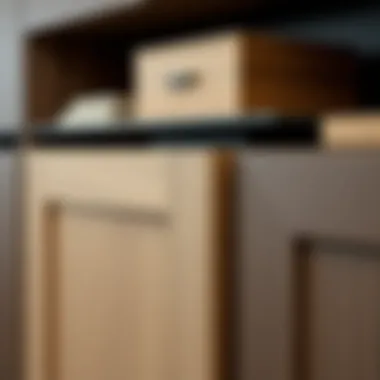
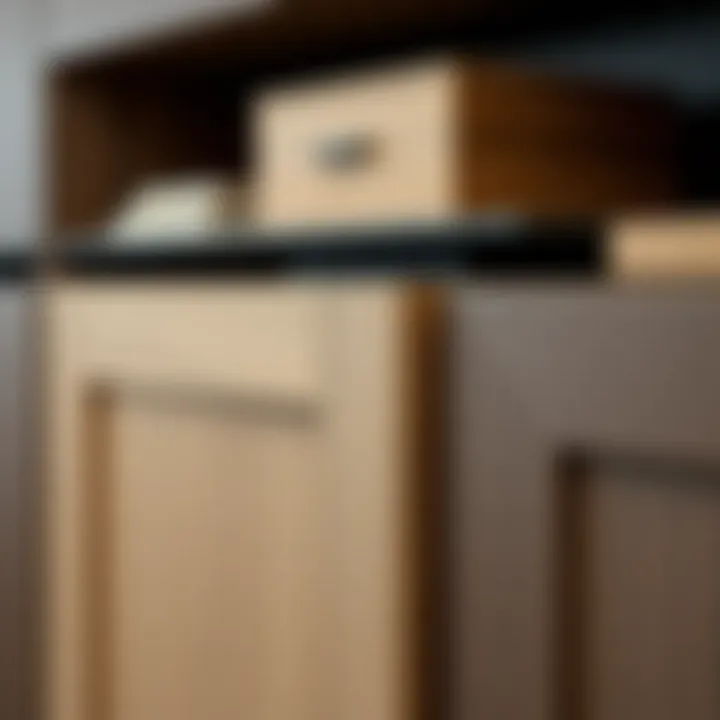
Understanding the dynamics influencing office cabinet prices is essential for making informed purchasing decisions. The price of office cabinets does not solely hinge on a numerical value; instead, it reflects various factors such as material choices, design specifications, brand recognition, and the market landscape. This nuanced exploration of pricing will help homeowners, designers, and retailers alike comprehend what they are paying for and why.
Material Selection and Its Impact
Solid Wood
Solid wood cabinets offer a robust and timeless appeal that many prefer. They are made from real hardwood, which gives them an undeniable strength and aesthetic charm. One key characteristic of solid wood is durability; if cared for properly, these cabinets can last a lifetime. This contributes significantly to their cost. The unique feature of solid wood lies in its natural grain patterns and the fact that no two pieces are identical. While they tend to be on the higher end price-wise, the advantages often outweigh the initial investment. Potential downsides include susceptibility to environmental changes, as wood can warp or crack if not maintained under proper humidity conditions.
Particleboard
On the other hand, particleboard is often seen as a budget-friendly alternative. It consists of compressed wood fibers and resin, making it lightweight and easier to handle. One significant aspect of particleboard is its affordability, which makes it a popular choice for those just starting out or looking to furnish a short-term space. The unique feature here is the ability to laminate it, allowing for a variety of finishes that can replicate wood at a fraction of the cost. However, the trade-off is often durability and a tendency to sag under heavy loads, which can affect long-term usability.
Metal
Metal cabinets are another strong contender and are best known for their modern and sleek appearance. They are generally more durable against wear and tear, making them ideal for high-traffic office environments. A key characteristic of metal is its resistance to moisture and pests, which often plague wood options. This aspect makes metal cabinets exceptionally low-maintenance. However, they can be heavier and less customizable than wood or particleboard, presenting a hurdle for certain aesthetic preferences. The unique advantage of metal cabinets lies in their strength and the industrial aesthetic they can impart to an office space.
Design Complexity
Customization Options
Customization in office cabinets allows buyers to tailor their purchases to meet specific needs, blending function with personal style. This level of customization is often seen as a hallmark of higher-quality options, potentially driving up the cost. One important feature of customization lies in the adaptability of storage solutions to fit different spaces, allowing for efficient use of office layouts. The complexity here offers a unique selling point; from adjustable shelves to lockable compartments, it meets varied requirements efficiently. However, high levels of customization might lengthen lead times and elevate prices, creating a balance to consider.
Style Variations
Another consideration in design complexity is the array of style variations available—modern, traditional, minimalist, and more. Each style reflects certain aesthetics and functions, catering to different office environments. The key characteristic of style variation is its impact on perceived value. An appealing style can potentially enhance a workplace’s branding and enhance employee morale. There’s a diverse range of finishes, colors, and hardware, that can significantly affect the price tag.
While style create an opportunity for expression, it can sometimes lead to confusion over what truly aligns with practical needs versus just visual appeal.
Brand Reputation and Warranty
Brand reputation is crucial when evaluating office cabinet prices. Established brands often charge more due to their credibility and history of product reliability. Renowned companies invest in research and development, resulting in durable and well-crafted cabinets. An important aspect of brand reputation ties into trust; consumers feel secure investing in known names backed by positive reviews.
Warranties similarly play into this equation. A strong warranty often signals confidence in a product, offering buyers reassurance against defects and longevity concerns. However, it can also inflate prices, especially among top-tier brands. Ultimately, spending more on a reputable brand with a solid warranty can be seen as an investment in peace of mind.
Price Ranges of Office Cabinets
Understanding the price ranges of office cabinets is crucial for anyone looking to furnish a workspace efficiently. The cost often correlates with the cabinet's materials, design complexity, and brand reputation. By becoming familiar with different price levels, consumers can make informed choices that not only align with their budgets but also meet their functional and aesthetic needs.
When evaluating options, it's beneficial to consider the longevity, style, and utility of various cabinets. Some may argue that going for budget options can save a penny, but it might cost more in the long run if replacements or repairs come into play. On the flip side, splurging on high-end models doesn't guarantee satisfaction if they're not fit for one’s purpose. The nuanced spectrum of pricing offers something for every need.
"A penny saved is a penny earned, but sometimes, investing a dollar is worth ten later on."
Budget-Friendly Options
Budget-friendly office cabinets serve as an attractive option for those on a tight budget but still aim for adequate quality. Typically, these cabinets range from $100 to $300. Materials like particleboard or laminated surfaces often characterize these selections, providing decent durability without breaking the bank. They come in various styles, from basic file cabinets to those featuring simple shelves and drawers.
Investing in these models can be worthwhile as they often suit temporary setups or small home offices. However, it's essential to keep in mind the trade-offs in durability and overall design appeal. You might not find the elegant finishes or intricate craftsmanship of higher-priced options, but functional designs can still fit in and perform adequately.
Mid-Range Selections
Mid-range cabinets usually sit between $300 to $700, striking a balance between quality and affordability. These pieces might use better materials, such as solid woods or higher-grade particleboard, making them more resilient over time. Moreover, mid-range cabinets often come with more style variations and customization options.
Choosing mid-range office cabinetry can enhance the workspace experience without a financial hangover. They often feature innovative designs with thoughtful ergonomics, making them attractive to both homeowners and business professionals. Such models can withstand daily use while looking sleek and professional, offering a good compromise between economy and aesthetic appeal.
High-End Choices
High-end cabinets can command prices that range anywhere from $700 to several thousand dollars, depending on the craftsmanship, materials, and design intricacy. Made from solid wood or premium metals, these cabinets often boast bespoke designs, customized finishes, and a level of durability that justifies their price tags.
High-end options provide a luxurious feel to a workspace, potentially enhancing productivity and satisfaction. Though they require a more substantial investment, the value often reflects in factors like materials that endure the test of time, warranties that assure quality, and unique designs that elevate the office environment. So, while it may sting to empty your wallet, the benefits may outweigh the costs in terms of aesthetics and longevity.
Evaluating Cost-Effectiveness
When it comes to investing in office cabinets, the term cost-effectiveness often becomes a pivotal consideration for many buyers. This section aims to shed light on why understanding the cost-effectiveness of office cabinets matters significantly, particularly for those who seek value without compromising on quality and functionality.
The ultimate goal is to ensure you choose cabinets that not only fit your budget but also serve their purpose efficiently over time. Cost-effectiveness is not simply about the initial price tag; it encompasses how well the cabinets perform in terms of longevity, style, and usability—all while keeping maintenance costs manageable.
Comparing Long-Term Value
The art of evaluating long-term value is crucial in navigating the office cabinet market. It's tempting to opt for the cheapest option available, but often, that decision leads to higher costs down the line. Consider a cabinet made from particleboard; at first glance, the price may seem appealing. However, such materials may not hold up as well against wear and tear over time. You could find yourself back-to-square-one, having to purchase a replacement much sooner than expected. On the other hand, investing in a solid wood cabinet may require a heftier budget upfront but can provide years—even decades—of reliable service.
Some key factors to consider when weighing long-term value include:
- Material Quality: High-quality materials often equate to better durability and, therefore, lower lifetime costs.
- Functionality and Design: A well-designed cabinet that fits your specific needs will save time and effort in your daily office routines.
- Resale Value: Some pieces retain value better than others, so consider future resale potential.
This perspective shifts the focus from simply looking at the price now to correlating costs and benefits over the cabinet's lifespan.


Assessing Durability and Maintenance Needs
Durability is not just an afterthought; it’s a cornerstone of sound investment. When evaluating office cabinets, understanding their ability to withstand the rigors of daily use is essential. Enter the world of maintenance needs.
Ask yourself: How much effort am I willing to put into maintaining this cabinet? Solid wood cabinets are generally easy to repair and maintain since scratches can often be sanded out or refinished. Conversely, particleboard pieces might be more susceptible to damage from moisture and may require more frequent replacement.
Here are a few points to consider when assessing durability and maintenance:
- Construction Quality: Look for solid joints and robust hardware that enhance longevity.
- Surface Treatment: A well-finished surface can help resist scratches and stains, thereby cutting down maintenance over time.
- Manufacturer Guidelines: Some manufacturers provide detailed care instructions that can extend the lifespan of your cabinets significantly.
In short, evaluating durability and maintenance needs arms you with the knowledge to understand not just the upfront costs, but the long-term care involved.
"An investment in quality office furniture is an investment in productivity."
By approaching your cabinet purchase with a mindset toward cost-effectiveness, you’ll ultimately make decisions that align with both fiscal responsibility and workplace comfort.
Market Trends Influencing Pricing
In today’s dynamic marketplace, the pricing of office cabinets is not just a simple matter of materials and designs. It’s closely tied to broader market trends that can significantly impact costs while also reflecting consumer demands and preferences. Being aware of these trends is not just a side note; it’s essential for making informed purchasing choices. By understanding these influences, consumers and designers alike can avoid pitfalls and capitalize on advantages when selecting cabinets for their workspaces.
Sustainability and Eco-Friendly Options
Sustainability has made a huge splash in the furniture industry, and office cabinets are no exception. Many buyers now look for materials and practices that are kind to the environment. This has led to a rise in the availability of eco-friendly cabinets made from reclaimed wood or manufactured using sustainable processes. Although premium prices often accompany these options, the long-term benefits typically outweigh the initial cost.
- Materials: Look for certifications like FSC (Forest Stewardship Council), which ensures that wood comes from responsibly managed forests. Being conscious of the materials not only aids the ecosystem but also enhances the workspace’s aesthetic as reclaimed wood often has a unique charm.
- Manufacturing Processes: Choosing brands that use non-toxic finishes and adhesives can improve air quality in your office. Products with low or zero VOCs (volatile organic compounds) are great choices for maintaining a healthier workspace.
- Energy Efficiency: Some companies focus on energy-efficient manufacturing methods, reducing the carbon footprint of their operations. By endorsing such brands, consumers play their part in a larger environmental movement.
Unlike trends that may come and go, sustainability seems more than just a fad. As people become increasingly aware of climate issues, opting for eco-friendly cabinet choices is likely to grow in popularity.
"Sustainable practices are not only a necessity, they are also becoming an essential expectation for modern consumers."
Technology Integration
The office environment is rapidly evolving, and technology is at the forefront of this change. As offices shift towards smart spaces, office cabinets must also adapt to the new technological landscape. This integration of technology into cabinet design can lead to price variations, often reflecting the added functionality.
- Smart Features: Incorporating technology such as built-in USB ports, wireless charging stations, or integrated lighting can make cabinets much more functional. While these features might bump up the price, they can also enhance productivity by providing convenience and efficient workspace organization.
- Modular Systems: Technology enables designs that are more flexible and modular. Cabinets that can be easily reconfigured to suit different needs might have a higher initial cost but can save money in the long run by adapting to changing office layouts or uses.
- E-Commerce Impact: Online sales have influenced how prices fluctuate. With increased competition among brands selling technology-enhanced cabinets, consumers can often find better deals online compared to what traditional stores offer.
Regional Pricing Variations
Understanding regional pricing variations is crucial when it comes to making informed decisions about office cabinets. Different geographic locations can impact not only the base price of cabinets but also availability, shipping costs, and even consumer preferences. Evaluating these factors can lead to significant savings and a better overall purchasing experience.
Impact of Geographic Location
Geographic location plays a pivotal role in the pricing of office cabinets. It’s not just a matter of convenience; local economies, population densities, and even cultural factors contribute to the overall cost. For instance, cities like San Francisco and New York tend to have higher living costs, which often translates to elevated prices for furniture, including office cabinets. This can make finding budget-friendly options quite challenging.
Conversely, rural areas may have lower prices, but options could be limited, necessitating online purchases or trips to larger cities. It's essential to weigh the pros and cons associated with your specific location. For example:
- Urban Areas: Higher prices due to increased demand and cost of living but often offer a wider selection.
- Rural Areas: Lower prices might be available, but choices can be restricted, and shipping costs can be steep for items that are not readily available locally.
This divergence calls for savvy consumers to list down potential costs and evaluate where the best value is found without sacrificing quality.
Local Market Dynamics
Market dynamics can shift based on local trends, economic conditions, and competitive landscapes. If there’s a high number of retailers competing for customers in your area, prices could be driven down. Alternatively, if you're in a market dominated by a few suppliers, you might not be able to catch a break price-wise.
A deeper look at local dynamics reveals:
- Competition Levels: More competition often leads to better pricing, promotions, and sales.
- Economic Conditions: Local economic health influences consumer spending power, affecting how much retailers can charge.
- Trends: Local tastes in design can affect what styles are popular and, by extension, what prices can be expected. Cabinets featuring sustainable materials may be more sought after in areas where eco-friendliness is paramount, which can raise prices.
In short, understanding local market dynamics can empower consumers with the knowledge they need to make an advantageous purchase. Do a little homework about the local cabinets sellers, check their pricing against online retailers, and keep an eye on any regional sales events that might pop up.
"Being aware of regional pricing variations might just save you a pretty penny or two while you hunt for that perfect office cabinet."
By combining insights about geographic influences and local market trends, buyers can engage in a strategic approach that emphasizes not only the immediate costs but also the potential long-term value of their office cabinets.
DIY vs. Pre-Made Cabinets


When it comes to choosing the right office cabinets, there’s quite an ongoing debate between DIY projects and purchasing pre-made options. This section is critical, as it influences the overall expenses and the outcome of the investment made for office organization and aesthetics.
Both options have their pros and cons, and understanding these can empower consumers to make the right decision based on their unique needs, preferences, and budgets.
Cost Benefits of DIY
Delving into DIY cabinets, they can indeed bring a notable cost advantage. Typically, materials like plywood or MDF boards, which are relatively inexpensive, can form the backbone of a DIY project. The cost savings can be quite significant compared to pre-made options where brand names and assembly time come into play.
Some points to think about when weighing the cost benefits of DIY include:
- Material Savings: By sourcing your materials directly, you can find deals and discounts, ultimately trimming down the total expenses. This can be especially advantageous if you're handy with tools.
- Customization Options: DIY allows you to tailor the design to fit your exact workspace and style, eliminating the need for costly modifications.
- Satisfaction and Personal Touch: Finishing a DIY project can often provide a sense of achievement, knowing that you created something from scratch that meets your exact specifications.
However, it is crucial to weigh these benefits against potential pitfalls, such as the time invested and the level of skill required. Not everyone forges a strong bond with woodworking or assembly, which is where that satisfaction can turn into frustration if things go awry.
Quality Considerations for Pre-Made Options
On the other hand, pre-made cabinets come with their own unique advantages, particularly in the quality department. Many of these products are crafted by professionals, meaning that the construction tends to follow industry standards. This can lead to predictors of longevity and durability that might be challenging to duplicate in a DIY scenario.
Key points to consider concerning pre-made cabinets include:
- Expert Craftsmanship: When opting for established brands, you typically receive a product that's been refined over time, minimizing any risk of flaws.
- Time Efficiency: Getting a pre-made option eliminates the need for assembly and installations, allowing you to set up your office quickly.
- Warranties and Guarantees: Many manufacturers provide warranties that assure a level of quality, giving peace of mind to the investment.
In summary, while DIY cabinets may appear more affordable and customizable, pre-made cabinets present a reliably crafted product that saves time and comes with assurances. Consequently, every buyer needs to carefully assess their skills, budget, and time constraints before making a decision.
Consider reviewing discussions on community platforms, such as Reddit, to see firsthand experiences shared by DIY enthusiasts and those who opted for pre-made solutions.
Where to Purchase Office Cabinets
When it comes to office cabinets, choosing the right place to buy them can significantly impact both the selection and the cost. The options are quite diverse, ranging from online outlets to physical stores. Each avenue comes with its own set of pros and cons. Understanding these aspects is vital for homeowners, designers, and DIYers alike.
Online Retailers and Their Pricing Models
Online retailers have become a popular choice for many consumers. One of the main advantages you gain with online shopping is the vast selection. Websites like Amazon, Wayfair, and Ikea offer endless options catering to different tastes and budgets. But let’s dig deeper into the pricing models these platforms often adopt:
- Dynamic Pricing: Many online stores adjust their prices based on market demand, seasonality, or even user behavior. This means that prices can fluctuate day to day, which can be a win for savvy shoppers who are willing to wait for the right deal.
- Free Shipping Offers: Online retailers often incentivize purchases through free shipping options. Checking if your order exceeds a certain threshold can save you a considerable amount.
- Membership Discounts: Websites like Amazon offer membership programs that can provide additional savings. An investment in a membership could pay off if you're planning to purchase multiple office cabinets over time.
However, caution should be exercised when shopping online as you don't always get to touch and feel the product before purchasing. This can lead to dissatisfaction when the cabinet arrives and doesn't meet your expectations in terms of quality or size.
Physical Stores and Showrooms
On the other end of the spectrum, physical stores and showrooms offer a quite different shopping experience. When you step into a showroom, you can see the products up close and assess the quality firsthand. Stores like Home Depot and Staples allow you to interact with the cabinets, which is something online shopping simply can't replicate. Here are some considerations when opting for physical stores:
- In-Person Assessment: Seeing and touching the cabinet gives you insight into its sturdiness and finish. You can better gauge if the color fits your office’s decor too.
- Expert Guidance: The sales staff at these stores often possess a wealth of knowledge. Speaking to someone who understands the products can provide you insights you might not have considered.
- Immediate Availability: Physical stores allow you to take the product home immediately, saving you from waiting days or weeks for delivery. This is especially useful if you're in a pinch to set up an office quickly.
However, one trade-off here is that selection might be more limited compared to what you might find online.
In summation, both online retailers and physical stores have unique advantages and drawbacks when it comes to purchasing office cabinets. Your choice depends on your priority— be it price, convenience, or personal evaluation of the product. It's about striking a balance that suits your needs effectively.
"Choosing where to purchase office cabinets can be as crucial as the cabinet itself; each option opens a different world of possibilities and limitations."
By weighing your options and understanding what each shopping avenue offers, you can make an informed decision that aligns with your needs and budget.
Closure
The exploration into office cabinet pricing reveals intricacies that often go unnoticed by consumers. It is crucial to recognize that the cost of office cabinets encompasses a wide range of factors, including material quality, design features, and market trends. Paying attention to these elements equips buyers with the knowledge necessary to make informed decisions that align with both their budget and aesthetic tastes.
Summarizing Key Points
Navigating through the content, several pivotal points emerge:
- Quality and Material Matter: The choice between solid wood, particleboard, or metal can significantly affect not only the price but also the longevity and usability of the cabinet.
- Understanding Design Complexity: Customization and style variations contribute to pricing structures and should be assessed in the context of personal taste and functional need.
- The Importance of Market Awareness: Recognizing current trends, such as eco-friendliness and tech integration, plays a vital role in evaluating the overall value of office cabinets.
- Pricing Ranges: It’s necessary to differentiate between budget, mid-range, and high-end options to ensure one is making a sensible choice based on their financial constraints.
- Informed Purchasing Decisions: Whether one chooses DIY or pre-made cabinets, understanding cost-effectiveness and durability can lead to satisfying purchases that stand the test of time.
"Investing in quality office cabinets is not just about aesthetics; it’s about creating a functional space that enhances productivity."
Final Thoughts on Making the Right Choice
As you stand on the brink of purchasing office cabinets, take a moment to reflect on your specific needs and long-term goals. Every component you choose—from the material to the design—speaks to your vision of an ideal workspace. It's not simply about filling a space; it’s about creating an environment that fosters creativity and efficiency.
Moreover, consider your geographical context, as prices can vary widely across different regions and stores. Engage with both online retailers and physical showrooms to gather a broad perspective. Ask questions, compare warranties, and lean on brand reputations.
In closing, remember that the best choice isn't always the cheapest or the most glamorous. It’s about striking a balance between cost, quality, and your unique preferences. By following the understanding gained from this guide on office cabinet pricing, you can confidently make a well-informed choice that brings lasting value to your space.







